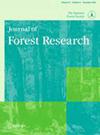日本柏树(Chamaecyparis obtusa)多子代试验点生长性状遗传参数的年龄变化趋势及遗传增益
IF 1.1
4区 农林科学
Q3 FORESTRY
引用次数: 0
摘要
摘要对日本关东育种区28个子代试验点的长尾Chamaecyparis obtusa生长数据进行分析,估算遗传参数和遗传增益。具体来说,利用这些数据估算了胸径、树高和茎体积,以评估育种的可行性,并澄清了遗传参数和遗传增益在生长性状上的差异,这些差异与年龄和气候条件有关。各年龄段胸径和胸径的狭义遗传力中位数分别为0.229 ~ 0.263和0.201 ~ 0.433。基于改良效率(每年遗传增益),似乎胸径和茎体积的最有效选择将是改良目标年龄(本研究中设置为30岁)的三分之一。分析了不同气候条件下三组试验点的狭义遗传力和年龄趋势的变化。年龄和群龄互作分别对胸径和体积的狭义遗传力和胸径和体积的狭义遗传力有显著影响。然而,组龄互作对各性状年增重效率的影响不显著,说明该参数可能不受气候条件的影响。因此,有人提出,在所有气候组中,早期选择几乎具有相同的效率。来自国家森林、县和林木育种中心(FTBC)以及林业和林产品研究所的工作人员建立、维护并调查了本研究中使用的子代试验点。此外,FTBC工作人员一直在持续管理本研究中使用的数据。我们赞赏他们的不懈努力。研究版面由YT、MM、MO、AT和MT设计,MM协助进行统计分析。稿件由YT分析起草。所有作者都通过讨论发现和结论为最终稿件做出了贡献。披露声明作者声明他们没有任何竞争利益。补充材料本文的补充数据可在https://doi.org/10.1080/13416979.2023.2265004上在线获取本文章由计算机程序翻译,如有差异,请以英文原文为准。
Age trends in genetic parameters and genetic gains of growth traits in multiple progeny test sites of hinoki cypress ( Chamaecyparis obtusa )
ABSTRACTGrowth data obtained from Chamaecyparis obtusa growing at 28 progeny test sites in the Kanto breeding region of Japan were analyzed to estimate the genetic parameters and genetic gains. Specifically, the data were used to estimate stem diameter at breast height (DBH), tree height (TH), and stem volume in order to assess the feasibility of breeding, and differences in genetic parameters and genetic gains associated with growth traits based on age and climatic conditions were clarified. The median values of narrow-sense heritability for DBH and TH across all ages ranged from 0.229 to 0.263 and from 0.201 to 0.433, respectively. Based on the efficiency of improvement (genetic gain per year), it appears that the most efficient selection for DBH and stem volume would be at one-third of the improvement target age (set to 30 years in the present study). We analyzed the variation of narrow-sense heritability and age trends of those among three groups of test sites exposed to different climatic conditions. Age and group × age interaction were shown to have significant effects on the narrow-sense heritability of TH and volume and that of DBH and volume, respectively. However, no significant effects of group × age interaction were detected on the efficiencies for gain per year of all traits, implying that this parameter might not be affected by climate conditions. Therefore, it was suggested that early selection is possible with almost equal efficiency in all climate groups.KEYWORDS: Climate conditionheritabilitygenetic correlationgenetic gain AcknowledgementsStaff from the National Forests, the Prefectures and Forest Tree Breeding Center (FTBC), and the Forestry and Forest Products Research Institute established, maintained, and investigated the progeny test sites used in this study. Furthermore, the FTBC staff has been continuously managing the data used in this study. We appreciate their never-ending efforts.Author contributionsThe research layout was designed by YT, MM, MO, AT, and MT. MM assisted with the statistical analysis. The manuscript was analyzed and drafted by YT. All authors contributed to the final manuscript by discussing the findings and conclusion.Disclosure statementThe author(s) state that they do not have any competing interests.Supplementary materialSupplemental data for this article can be accessed online at https://doi.org/10.1080/13416979.2023.2265004
求助全文
通过发布文献求助,成功后即可免费获取论文全文。
去求助
来源期刊

Journal of Forest Research
农林科学-林学
CiteScore
3.00
自引率
6.70%
发文量
62
审稿时长
3 months
期刊介绍:
Journal of Forest Research publishes original articles, reviews, and short communications. It covers all aspects of forest research, both basic and applied, with the aim of encouraging international communication between scientists in different fields who share a common interest in forest science.
 求助内容:
求助内容: 应助结果提醒方式:
应助结果提醒方式:


